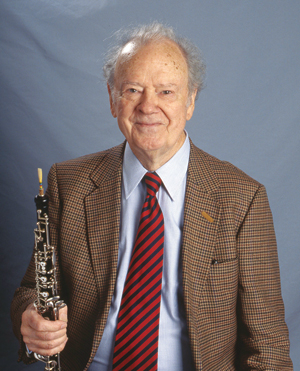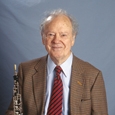 Renowned oboist Ray Still died on March 12, 2014 in Woodstock, Vermont. It was Still’s 94th birthday, and he died surrounded by family. Still was the principal oboist of the Chicago Symphony Orchestra for 40 years, from 1953 to 1993. Still played under four different music directors during his tenure with the orchestra, including Fritz Reiner, who hired Still in 1953, and Sir Georg Solti. Regarding Reiner, Still once stated: “Fritz Reiner was the greatest conductor with whom I have ever played.”
Renowned oboist Ray Still died on March 12, 2014 in Woodstock, Vermont. It was Still’s 94th birthday, and he died surrounded by family. Still was the principal oboist of the Chicago Symphony Orchestra for 40 years, from 1953 to 1993. Still played under four different music directors during his tenure with the orchestra, including Fritz Reiner, who hired Still in 1953, and Sir Georg Solti. Regarding Reiner, Still once stated: “Fritz Reiner was the greatest conductor with whom I have ever played.”
Still also taught as professor of music at Northwestern University from 1960 through 2003. On the occasion of his 90th birthday, in March 2010, Northwestern invited Still to teach a series of masterclasses at the school. In honor of the event, the Chicago classical music station WFMT devoted programming time to playing a number of Still’s many recordings as an orchestral, chamber, and solo artist.
In an article published in The Instrumentalist in December 2002, Still shared his thoughts on his career and his views on oboe technique. Below are several excerpts from that article.
On his first experience playing oboe:
“I vividly remember the first time I tried to produce a sound on the oboe. At age 16 after having played the clarinet for two years, I decided to try the oboe. As I tried to produce a sound, my immediate reaction was that no air was going through the instrument. Probably I was closing the reed too much, but even after I improved the embouchure and the reed vibrated, the amount of air going through seemed too tiny. My body reacted to this very low flow rate, and it was as though I were holding my breath.”
On overcoming breathing challenges:
“The oboe has been called the most difficult of all the wind instruments, and if this is true, the main reason is that it takes so little air. … somehow I had to handle the breathing problem. It took many years of experimentation for this to happen, and this was the best way for me at least, because I learned more thoroughly that way.”
On working with Arnold Jacobs:
“My last teacher taught me more about the basics of oboe playing than all of the others, and he was a tuba player. The tuba is the opposite of the oboe because it uses more air than any other instrument. When I joined the Chicago Symphony in 1953, I was fortunate to be a colleague of one of the world’s great tuba players, Arnold Jacobs. We worked together for most of the 40 years that I played first oboe with the Chicago Symphony and discussed all of my experiments and ideas.
“Whenever I had a problem with some aspect of tone production, I soon learned that Arnold had encountered it many times before with students on every brass and woodwind instrument. I might have been the first oboist he worked with on breathing.”
On breathing and posture:
“Oboists seldom use more than half of the available air. Because the oboe takes so little air many young players can get away with just lowering the upper chest (by hunching the shoulders forward). … Over time, this approach to blowing feels quite normal and easy, but big trouble arises when students play more sophisticated music. The best, most efficient way to play the oboe is with the chest high and regal, like any competent singer. I have seen and felt my chest rise slightly as I play through most of a phrase. It only comes down at the end if I need all of my breath, which is almost never.”
On a rehearsal of Beethoven’s Fifth:
“During one very hot afternoon rehearsal at Ravinia, the outdoor summer home of the Chicago Symphony, we worked on Beethoven’s Fifth with conductor James Levine, who was an old friend. Everyone was a bit sleepy, and the orchestra almost played this all-too-familiar work by rote. I decided to play the solo in the Scherzo using the reed alone, even though those four C3s are a prominent oboe solo. Levine cued me and did a double take when he discovered that I was playing on just the reed, but no one else in the orchestra noticed it.”
On practicing and training:
“The training to condition the blowing muscles is extremely difficult and can only be learned by doing it. Just as a prizefighter has to learn how to survive in the ring by experience and training, so too is it necessary for oboists to spend a great deal of practice on these arduous passages. It is futile to spend most of the time making reeds in the hope that a great reed will get us through it. Take a mediocre reed and learn to survive without stopping.”
On advice given about breathing and blowing:
“A final word about breathing and blowing concerns frequent comments and advice by professional oboists about spinning the breath or speeding it up with the tongue position. To me, all such advice is just so much hocus-pocus. It is absolutely immaterial where the air has passed before reaching the reed.
“Whatever psychological adjustments a player may imagine are irrelevant to the reed and the sound unless these images alter the embouchure or the air pressure. The reed couldn’t care less about what happens as the air moves from the lungs, through the mouth, and to the reed tip. However, psychological images can make a great deal of difference in coping with the common feeling that an oboist is suffocating from too much CO2. With good breath control, the air will get to the reed in the right quantities at the right time.”





